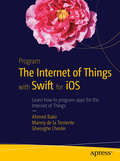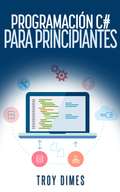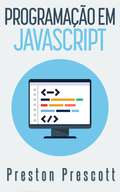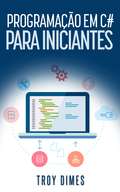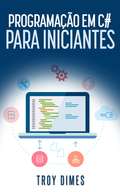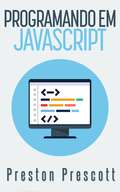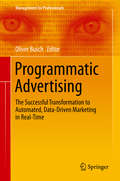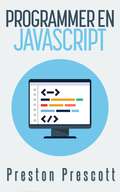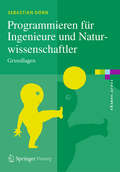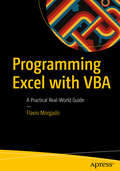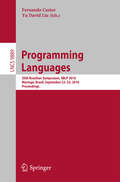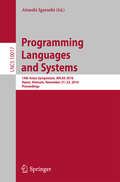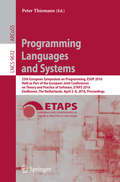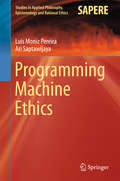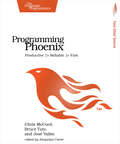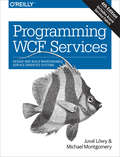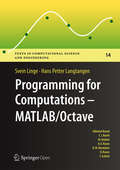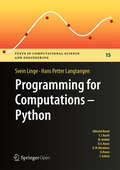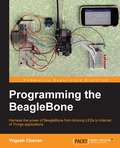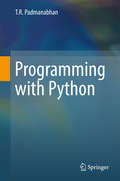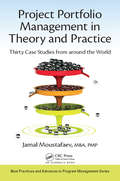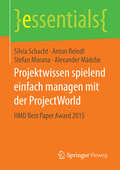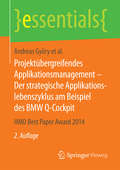- Table View
- List View
Program the Internet of Things with Swift for iOS
by Ahmed Bakir Gheorghe Chesler Manny TorrienteProgram the Internet of Things with Swift and iOS is a detailed tutorial that will teach you how to build apps using Apple's native APIs for the Internet of Things, including the Apple Watch, HomeKit, and Apple Pay. This is the second book by Ahmed Bakir (author of Beginning iOS Media App Development) and his team at devAtelier LLC, who have been involved in developing over 20 mobile projects. Written like a code review, this book presents a detailed "how" and "why" for each topic, explaining Apple-specific design patterns as they come up and pulling lessons from other popular apps. To help you getting up and running quickly, each chapter is framed within a working project, allowing you to use the sample code directly in your apps. The Internet of Things is not limited to Apple devices alone, so this book also explains how to interface with popular third-party hardware devices, such as the Fitbit and Raspberry Pi, and generic interfaces, like Restful API's and HTTPS. The Internet of Things is waiting -- be a part of it! What you'll learn How to use HealthKit to log and retrieve fitness information in your apps. How to use Core Motion to access the iPhone's built-in motion sensors. How to use WatchKit to build a watch face. How to use WatchKit to build an interactive watch app. How to take advantage of the advanced sensors on the Apple Watch. How to communicate with Bluetooth LE devices. How to communicate with iBeacons. How to communicate with a Raspberry Pi. How to use Keychain Services to encrypt data within your apps. How to use Touch ID to add fingerprint-based authentication to your apps. How to use Apple Pay to accept payments within your apps. Who this book is for Intermediate-level developers who have experience building iOS apps, but are looking to integrate Internet of Things API's into their apps. This book provides a tutorial-based approach that introduces advanced iOS topics as they come up and pulls in lessons from other popular apps. Table of Contents Part 1: Getting Started Chapter 1: Welcome to the Internet of Things Chapter 2: Introduction to the Swift Programming Language Chapter 3: Live Debugging with Xcode Part 2: Health Chapter 4: Logging and retrieving health information using HealthKit Chapter 5: Tracking activity using the iPhone's internal sensors Chapter 6: Integrating third-party fitness trackers using the Fitbit API Part 3: WatchKit Chapter 7: Building a static watch face Chapter 8: Building an interactive watch app Chapter 9: Advanced sensors and controls on the Apple Watch Part 4: Communicating with External Hardware Chapter 10: Connecting to a Bluetooth LE device Chapter 11: Building location awareness with iBeacons Chapter 12: Home automation using HomeKit Chapter 13: Building an app that talks to a Raspberry Pi Part 5: An Internet of Secure Things Chapter 14: Using Keychain Services to secure data Chapter 15: Using Touch ID for authentication Chapter 16: Using Apple Pay to accept payments
Programación en C# para Principiantes
by Maria Jimenez Troy DimesComo un gesto de agradecimiento por leer "Programación en C# para Principiantes", me gustaría regalarle una copia de "7 pequeños trucos de programación en C#" Para descargar la copia, visita el siguiente sitio: http://www.linuxtrainingacademy.com/7-tricks
Programando em JavaScript
by Preston Prescott Mayara ÁvilaDescrição: Cansado de tentar aprender a programar? Pronto para REALMENTE aprender a programar? Se você já tentou aprender a programar no passado mas não teve muito sucesso, dê uma chance ao livro "Programando em JavaScript". Ele lhe ensinará exatamente o que você precisa saber sobre programação na linguagem de script mais amplamente utilizada no mundo atualmente. Vai lhe instruir partindo do princípio e permitir seu desenvolvimento baseado naquilo que você aprendeu ao longo do caminho. Aprenda JavaScript uma vez, use muitas e muitas vezes! Apesar do JavaScript ser de longe a linguagem do lado cliente mais popular em uso atualmente, também pode e é usado do lado servidor. Node.js, Meteor, Wakanda, CouchDB e MongoDB são apenas alguns exemplos de onde você encontrará e poderá utilizar o JavaScript no lado servidor. O tempo que você investir aprendendo a utilizar o JavaScript pode ser duplamente recompensador, já que o JavaScript continua adentrando em outras áreas da computação. Se você está buscando alavancar sua carreira, JavaScript é uma inestimável habilidade para se ter. Há uma alta demanda por habilidades em JavaScript e a necessidade por pessoas que possam programar em JavaScript aumentará cada vez mais. Se você está buscando a inserção no mercado de trabalho, qual melhor habilidade para ter em seu currículo do que algo que pode ser utilizado praticamente em todo lugar? Quer trabalhar no "front-end" de sites? Aprenda JavaScript. Pronto para lidar com programação back-end para aplicativos web de rede intensiva? Aprenda JavaScript. Quer trabalhar com as mais recentes tecnologias em base de dados disponíveis atualmente? Então, aprenda JavaScript. Aprenda JavaScript da maneira certa - de uma vez por todas... Não importa se você planeja utilizar o JavaScript no lado cliente em um navegador, ou no lado servidor, ou mesmo em ambos; você
Programação em C# Para Iniciantes
by Troy Dimes Roger Senna RosaO C# é simples e poderoso! O C# é uma linguagem orientada a objetos de propósito geral. Combine sua versatilidade com sua extensa biblioteca padrão, é fácil ver por que essa é uma linguagem de programação tão popular e respeitada. Crie aplicações gráficas, aplicativos para web, e mais. Quando você aprender a programar em C#, você poderá desenvolver aplicações web ou aplicações gráficas para desktop. Uma das melhores características do C# é a facilidade para ser aprendido... especialmente com esse livro. Essa é uma pequena lista com algumas das coisas que você aprende aqui... O que é um IDE e qual eu devo usar para desenvolver aplicações em C#. Como criar seu primeiro programa. Os vários tipos de dados do C#. Operadores... aritméticos, relacionais e lógicos. Como iterar um conjunto de itens, usando quatro tipos de loop diferentes. Formas de tomar decisões no seu código. Sobre a programação orientada a objetos. O que são objetos e classes. Tudo sobre métodos e modificadores de acesso. Tópicos avançados, como herança e polimorfismo. Como criar aplicações multi-thread, para tirar vantagem das CPU's com vários núcleos. E mais... Exercícios práticos inclusos, para ajudar no seu aprendizado do C#. Inclui exercícios ao final de cada capítulo (junto com a solução) para você praticar o que aprendeu. É ótimo para programadores iniciantes, e até para aqueles que já conhecem outras linguagens. Se você nunca programou antes, não se preocupe. Esse livro irá te guiar passo-a-passo em como criar sua primeira aplicação. Se você já tem alguma experiência em programação, então esse livro vai te ensinar alguns detalhes inerentes ao C#. Volte ao início da página e clique em "Comprar" e comece a aprender C# ainda hoje!
Programação em C# para iniciantes
by Troy Dimes Henrique HenningComo um agradecimento pela aquisição de Programação de C# Para Iniciantes, eu gostaria de oferecer uma cópia gratuita de "7 Little-Known C# Programming Tricks." Para baixar sua cópia, visite: http://www.linuxtrainingacademy.com/7-tricks
Programação em JavaScript. Um Guia da Linguagem de Programação JavaScript para Iniciantes
by Preston Prescott Fernando SouzaDescrição: Você está cansado de tentar aprender a programar? Está pronto para aprender realmente a programar? Se você já tentou aprender a programar no passado, mas não teve muito sucesso, então, dê uma chance ao livro "Programação JavaScript". Ele vai te ensinar exatamente o que você precisa saber sobre a linguagem de script de programação mais utilizada do mundo hoje. Ele vai começar pela base e permitir que você construa o seu conhecimento sobre o que você aprendeu ao longo do caminho. Aprenda JavaScript de uma vez e use-a muitas vezes ... Apesar do JavaScript ser, de longe, a mais popular linguagem de programação do lado do cliente em uso hoje, ela também pode e é usada no lado do servidor. Node.js, Meteoro, Wakanda, CouchDB e MongoDB são apenas alguns exemplos de onde você vai encontrar e ser capaz de usar JavaScript no lado do servidor. O tempo que você investir no aprendizado do JavaScript pode ser duplamente gratificante pois o JavaScript continua abrindo caminhos em mais e mais áreas da computação. Se você estiver buscando como subir de nível a sua carreira, o JavaScript é uma habilidade de valor inestimável para você dominar. As habilidades em JavaScript estão em alta demanda e a demanda por pessoas que possam programar em JavaScript só vai aumentar. Se você está procurando um trabalho técnico, então, que melhor habilidade para ter em seu currículo do que algo que pode ser usado em praticamente qualquer lugar? Quer trabalhar no "front-end" de sites? Então, aprenda JavaScript. Pronto para enfrentar a programação back-end para intensivas aplicações web de rede? Aprenda JavaScript. Quer trabalhar nas mais recentes tecnologias de banco de dados disponíveis atualmente? Então, aprenda JavaScript. Saiba JavaScript da maneira certa, de uma vez por todas ... Não importa se você planeja usar o JavaScript no lado do cliente em um na
Programmatic Advertising
by Oliver BuschThisfundamental guide on programmatic advertising explains in detail how automated, data-driven advertisingreally works in practice and how the right adoption leads to a competitive advantage foradvertisers, agencies and media. The new way of planning, steering and measuring marketing maystill appear complex and threatening but promising at once to most decision makers. Thiscollaborative compendium combines proven experience and best practice in 22 articleswritten by 45 renowned experts from all around the globe. Among them Dr. Florian Heinemann/Project-A,Peter Würtenberger/Axel-Springer, Deirdre McGlashan/MediaCom, Dr. MarcGrether/Xaxis, Michael Lamb/MediaMath, Carolin Owen/IPG, Stefan Bardega/Zenith,Arun Kumar/Cadreon, Dr. Ralf Strauss/Marketingverband,Jonathan Becher/SAP and many more great minds.
Programmer en JavaScript
by Victor Thivillier Preston PrescottFatigué d'essayer d'apprendre à programmer? Prêt à vraiment apprendre comment programmer? Si vous avez essayé d'apprendre à programmer par le passé, mais n'avez pas eu beaucoup de succès, tentez le coup avec le livre « Programmer en JavaScript ». Il vous apprendra exactement ce que vous devez savoir sur le langage de script le plus largement utilisé dans le monde aujourd'hui. Vous commencerez par le début et le livre vous permettra de progresser en vous basant sur ce que vous aurez acquis au fur et à mesure. Apprenez le JavaScript une fois, utilisez-le encore et encore... Même si le JavaScript est de loin le langage de programmation côté client le plus populaire en usage aujourd'hui, il peut aussi être utilisé côté serveur. Node.js, Meteor, Wakanda, CouchDB et MongoDB ne sont que quelques exemples de frameworks avec lesquels vous serez en mesure d'utiliser JavaScript côté serveur. Le temps que vous à apprendre le JavaScript peut être doublement payant du fait que le JavaScript continue d’évoluer dans de plus en plus de domaines de l'informatique. Si vous cherchez à améliorer votre CV pour votre carrière, la maîtrise du JavaScript est une compétence inestimable. Les compétences JavaScript sont très fortement demandées et le besoin de personnes sachant programmer en JavaScript est en constante augmentation. Si vous cherchez à percer dans un domaine technique, quoi de mieux à ajouter sur votre CV que quelque chose qui peut être utilisé pratiquement partout? Vous voulez travailler sur le front-end (l’interface) de sites Web? Apprenez le JavaScript. Prêt à attaquer la programmation back-end pour les applications Web et réseau? Apprenez le JavaScript. Vous souhaitez travailler sur les technologies de bases de données les plus récentes? Apprenez le JavaScript. Apprenez le JavaScript de la bonne manière - une fois pour toutes... Peu importe si
Programmieren für Ingenieure und Naturwissenschaftler: Grundlagen (eXamen.press)
by Sebastian DörnZiel des Buches ist es, Studierenden der Ingenieur- oder Naturwissenschaften die Programmierung als Schlüsselqualifikation mit zahlreichen Anwendungsmöglichkeiten vorzustellen. Die Umsetzung von Programmierkonzepten und algorithmischen Verfahren erfolgt in diesem Buch in Java. Im ersten Teil gibt der Autor eine Einführung in die Grundkonzepte von Java, im zweiten Teil werden algorithmische Verfahren aus dem Bereich der Numerik, sowie allgemeine Methoden zum Entwurf von Algorithmen vorgestellt. Im dritten Teil werden Grundlagen der objektorientierten Programmierung dargestellt sowie ein Überblick über die Erstellung von graphischen Benutzeroberflächen gegeben. Ein Kapitel zu diversen Anwendungen aus dem Bereich der Ingenieur- und Naturwissenschaften sowie Aufgaben und Lösungen in jedem Kapitel runden das Buch ab.
Programming Excel with VBA: A Practical Real-World Guide
by Flavio MorgadoLearn to harness the power of Visual Basic for Applications (VBA) in Microsoft Excel to develop interesting, useful, and interactive Excel applications. This book will show you how to manipulate Excel with code, allowing you to unlock extra features, accuracy, and efficiency in working with your data. Programming Excel 2016 with VBA is a complete guide to Excel application development, using step-by-step guidance, example applications, and screenshots in Excel 2016.In this book, you will learn:How to interact with key Excel objects, such as the application object, workbook object, and range objectMethods for working with ranges in detail using codeUsage of Excel as a database repositoryHow to exchange data between Excel applicationsHow to use the Windows API to expand the capabilities of ExcelA step-by-step method for producing your own custom Excel ribbonWho This Book Is For:Developers and intermediate-to-advanced Excel users who want to dive deeper into the capabilities of Excel 2016 using code.
Programming Languages
by Fernando Castor Yu David LiuThis book constitutes the proceedings of the 20th Brazilian Symposium on Progamming Languages, SBLP 2016, held in Maring#65533;, Brazil, in September 2016. The 12 papers presented in this volume were carefully reviewed and selected from 26 submissions. They deal with fundamental principles and innovations in the design and implementation of programming languages and systems.
Programming Languages and Systems
by Atsushi IgarashiThis book constitutes the refereed proceedings of the 14th Asian Symposium on Programming Languages and Systems, APLAS 2016, held in Hanoi, Vietnam, in November 2016. The papers cover a variety of topics such as semantics, logics, and foundational theory; design of languages type systems, and foundational calculi; domain-specific languages; compilers, interpreters, and abstract machines; program derivation, synthesis and transformation; program analysis, verification, and model-checking; logic, constraint, probabilistic and quantum programming; software security; concurrency and parallelism; tools for programming and implementation.
Programming Languages and Systems
by Peter ThiemannThis bookconstitutes the proceedings of the 25th European Symposium on Programming, ESOP2016, which took place in Eindhoven, The Netherlands, in April 2016, held asPart of the European Joint Conferences on Theory and Practice of Software,ETAPS 2016. The 29 papers presented in this volume were carefully reviewed and selectedfrom 98 submissions. Being devoted to fundamental issues in the specification,design, analysis, and implementation of programming languages and systems, ESOPfeatures contributions on all aspects of programming language research;theoretical and/or practical advances.
Programming Machine Ethics
by Luís Moniz Pereira Ari SaptawijayaThis book addresses the fundamentals of machineethics. It discusses abilities required for ethical machine reasoning and theprogramming features that enable them. It connects ethics, psychologicalethical processes, and machine implemented procedures. From a technical pointof view, the book uses logic programming and evolutionary game theory to modeland link the individual and collective moral realms. It also reports on theresults of experiments performed using several model implementations. Opening specific and promising inroads into the terra incognita of machine ethics, theauthors define here new tools and describe a variety of program-tested moralapplications and implemented systems. In addition, they provide alternativereadings paths, allowing readers to best focus on their specific interests andto explore the concepts at different levels of detail. Mainly written for researchers in cognitivescience, artificial intelligence, robotics, philosophy of technology andengineering of ethics, the book willalso be of general interest to otheracademics, undergraduates in search of research topics, science journalists aswell as science and society forums, legislators and military organizationsconcerned with machine ethics.
Programming Phoenix: Productive |> Reliable |> Fast
by Bruce Tate Jose Valim Chris McCordDon't accept the compromise between fast and beautiful: you can have it all. Phoenix creator Chris McCord, Elixir creator Jose Valim, and award-winning author Bruce Tate walk you through building an application that's fast and reliable. At every step, you'll learn from the Phoenix creators not just what to do, but why. Packed with insider insights, this definitive guide will be your constant companion in your journey from Phoenix novice to expert, as you build the next generation of web applications.Phoenix is the long-awaited web framework based on Elixir, the highly concurrent language that combines a beautiful syntax with rich metaprogramming. The authors, who developed the earliest production Phoenix applications, will show you how to create code that's easier to write, test, understand, and maintain. The best way to learn Phoenix is to code, and you'll get to attack some interesting problems. Start working with controllers, views, and templates within the first few pages. Build an in-memory repository, and then back it with an Ecto database layer. Learn to use change sets and constraints that keep readers informed and your database integrity intact. Craft your own interactive application based on the channels API for the real-time, high-performance applications that this ecosystem made famous. Write your own authentication components called plugs, and even learn to use the OTP layer for monitored, reliable services. Organize your code with umbrella projects so you can keep your applications modular and easy to maintain.This is a book by developers and for developers, and we know how to help you ramp up quickly. Any book can tell you what to do. When you've finished this one, you'll also know why to do it.What You Need:To work through this book, you will need a computer capable of running Erlang 17 or better, Elixir 1.1, or better, Phoenix 1.0 or better, and Ecto 1.0 or better. A rudimentary knowledge of Elixir is also highly recommended.
Programming WCF Services: Design and Build Maintainable Service-Oriented Systems
by Juval Lowy Michael MontgomeryProgramming WCF Services is the authoritative, bestselling guide to Microsoft’s unified platform for developing modern, service-oriented applications on Windows. Hailed as the definitive treatment of WCF, this guide provides unique insight, rather than documentation, to help you learn the topics and skills you need for building maintainable, extensible, and reusable WCF-based applications.Authors Juval Löwy—one of the world’s top .NET experts—and Michael Montgomery have revised this edition to include the productivity-enhancing features of .NET Framework 4.6, along with the latest WCF ideas and techniques. By teaching you the why and the how of WCF programming, this book will help you master WCF and make you a better software engineer.Learn WCF’s architecture and essential building blocks, including key concepts such as reliability and transport sessionsUse built-in features such as service contracts, instance and concurrency management, transactions, queued services, and securityIncrease the quality of your WCF services by using design options, tips, and best practices in Löwy’s ServiceModelEx frameworkUnderstand the rationale behind particular design decisions, and rarely understood aspects of WCF developmentLearn why Azure Service Fabric is the killer app for modern DevOps
Programming for Computations - MATLAB/Octave
by Svein Linge Hans Petter LangtangenThis book presentscomputer programming as a keymethod for solving mathematical problems. There are two versions of the book,one for MATLAB and onefor Python. The book wasinspired by the Springer bookTCSE 6: A Primer on Scientific Programming with Python (by Langtangen), but the style is more accessible andconcise, in keeping with the needs of engineering students. The book outlines the shortest possible path from no previous experience with programming to a set ofskills that allows the students to write simple programs for solving commonmathematical problems withnumerical methods in engineering and science courses. The emphasis is on generic algorithms, cleandesign of programs, use of functions, and automatic tests for verification.
Programming for Computations - Python
by Svein Linge Hans Petter LangtangenThis book presentscomputer programming as a keymethod for solving mathematical problems. There are two versions of the book,one for MATLAB and onefor Python. The book wasinspired by the Springer bookTCSE 6: A Primer on Scientific Programming with Python (by Langtangen), but the style is more accessible andconcise, in keeping with the needs of engineering students. The book outlines the shortest possible path from no previous experience with programming to a set ofskills that allows the students to write simple programs for solving commonmathematical problems withnumerical methods in engineering and science courses. The emphasis is on generic algorithms, cleandesign of programs, use of functions, and automatic tests for verification.
Programming in Haskell
by Graham HuttonHaskell is a purely functional language that allows programmers to rapidly develop clear, concise, and correct software. The language has grown in popularity in recent years, both in teaching and in industry. This book is based on the author's experience of teaching Haskell for more than twenty years. All concepts are explained from first principles and no programming experience is required, making this book accessible to a broad spectrum of readers. While Part I focuses on basic concepts, Part II introduces the reader to more advanced topics. This new edition has been extensively updated and expanded to include recent and more advanced features of Haskell, new examples and exercises, selected solutions, and freely downloadable lecture slides and example code. The presentation is clean and simple, while also being fully compliant with the latest version of the language, including recent changes concerning applicative, monadic, foldable, and traversable types. This new edition has been extensively revised and expanded, including four new chapters as well as many new examples and exercises. Fully compliant with the latest version of Haskell, and updated to include more recent features. An accompanying website provides a range of supporting materials, including PowerPoint slides and Haskell code for the extended examples. <P><P><i>Advisory: Bookshare has learned that this book offers only partial accessibility. We have kept it in the collection because it is useful for some of our members. To explore further access options with us, please contact us through the Book Quality link on the right sidebar. Benetech is actively working on projects to improve accessibility issues such as these.</i>
Programming in Haskell
by Graham HuttonHaskell is a purely functional language that allows programmers to rapidly develop clear, concise, and correct software. The language has grown in popularity in recent years, both in teaching and in industry. This book is based on the author's experience of teaching Haskell for more than twenty years. All concepts are explained from first principles and no programming experience is required, making this book accessible to a broad spectrum of readers. While Part I focuses on basic concepts, Part II introduces the reader to more advanced topics. This new edition has been extensively updated and expanded to include recent and more advanced features of Haskell, new examples and exercises, selected solutions, and freely downloadable lecture slides and example code. The presentation is clean and simple, while also being fully compliant with the latest version of the language, including recent changes concerning applicative, monadic, foldable, and traversable types.
Programming the BeagleBone
by Yogesh ChavanMaster BeagleBone programming by doing simple electronics and Internet of Things projects About This Book * Quickly develop electronics projects that interact with Internet applications using JavaScript and Python * Learn about electronics components such as sensors and motors, and how to communicate with them by writing programs * A step-by-step guide to explore the exciting world of BeagleBone--from connecting BeagleBone to doing electronics projects and creating IoT applications Who This Book Is For If you want to learn programming on embedded systems with BeagleBone by doing simple electronics projects, this book is for you. This book is also helpful to BeagleBone owners who want to quickly implement small-scale home automation solutions. It is assumed that you have familiarity with C and Python programming. Some familiarity with electronics is helpful but not essential. What You Will Learn * Connect your BeagleBone to a computer in different ways and get the Cloud9 IDE running to quick-start programming on the BeagleBone * Get to know about BeagleBone extension pins such as GPIO and how to connect various electronics components with BeagleBone * Read and write to various electronics components such as LED, Push-button, sensors, and motors * Grasp in-depth theory on Analog, PWM, and BUS programming and the electronics components used in programs * Handle data to and from various BUS supporting modules such as UART, I2C, and SPI using the Adafruit BBIO Python library * Write real-life IoT applications in JavaScript and Python such as shooting an e-mail on overheat and controlling a servo motor remotely * Make use of online free cloud services to store and analyze sensor data collected on the BeagleBone * Discover what else can be done using the BeagleBone * Get to grips with embedded system BUS communication In Detail The whole world is moving from desktop computers to smartphones and embedded systems. We are moving towards utilizing Internet of Things (IoT). An exponential rise in the demand for embedded systems and programming in the last few years is driving programmers to use embedded development boards such as Beaglebone. BeagleBone is an ultra-small, cost-effective computer that comes with a powerful hardware. It runs a full-fledged Debian Linux OS and provides numerous electronics solutions. BeagleBone is open source and comes with an Ethernet port, which allows you to deploy IoT projects without any additions to the board. It provides plenty of GPIO, Anlaog pins, and UART, I2C, SPI pins which makes it the right choice to perform electronics projects. This gives you all the benefits of Linux kernel such as multitasking, multiusers, and extensive device driver support. This allows you to do programming in many languages including high-level languages such as JavaScript and Python. This book aims to exploit the hardware and software capabilities of BeagleBone to create real-life electronics and IoT applications quickly. It is divided into two parts. The first part covers JavaScript programs. The second part provides electronics projects and IoT applications in Python. First, you will learn to use BeagleBone as tool to write useful applications on embedded systems. Starting with the basics needed to set up BeagleBone and the Cloud9 IDE, this book covers interfacing with various electronics components via simple programs. The electronics theory related to these components is then explained in depth before you use them in a program. Finally, the book helps you create some real-life IoT applications. Style and approach An easy-to-follow guide full of real-world electronics programs and quick troubleshooting tips using BeagleBone. All the required electronics concepts are explained in detail before using them in a program and all programs are explained in depth. Most of the theory is covered in the first part; while the second part gives you some quick programs.
Programming with Python
by T R PadmanabhanBased on the latest version of the language, this book offers a self-contained, concise and coherent introduction to programming with Python. The book's primary focus is on realistic case study applications of Python. Each practical example is accompanied by a brief explanation of the problem-terminology and concepts, followed by necessary program development in Python using its constructs, and simulated testing. Given the open and participatory nature of development, Python has a variety of incorporated data structures, which has made it difficult to present it in a coherent manner. Further, some advanced concepts (super, yield, generator, decorator, etc. ) are not easy to explain. The book specially addresses these challenges; starting with a minimal subset of the core, it offers users a step-by-step guide to achieving proficiency.
Project Portfolio Management in Theory and Practice: Thirty Case Studies from around the World (Best Practices in Portfolio, Program, and Project Management #24)
by Jamal MoustafaevEvery CEO in the world, if questioned, will always complain that there are a lot of ideas to implement, but, unfortunately, insufficient resources to accomplish them. This book provides a solution to this dilemma by supplying techniques to assess the value of projects, prioritize projects, and decide which projects to implement and which to postpone. In addition, it describes various methods of balancing project portfolios and different strategic alignment models. The book provides thirty real-life project portfolio management case studies from pharmaceutical, product development, financial, energy, telecommunications, not-for-profit and professional services industries.
Projektwissen spielend einfach managen mit der ProjectWorld: HMD Best Paper Award 2015 (essentials)
by Silvia Schacht Anton Reindl Stefan Morana Alexander MädcheDie Autoren zeigen einen neuen Weg auf, gamifizierte Wissensmanagementsysteme mit der Anwendung spielerischer Elemente zu gestalten, und beschreiben die Anforderungserhebung, die Gestaltung und Evaluation des Systems. Hierbei gehen sie auf die theoretischen Grundlagen sowie die Umsetzung und Nutzung in einem Unternehmen ein. Mithilfe von Gamification-Mechanismen sollen Projektteams dazu motiviert werden, ihr Wissen und ihre Erfahrungen zu dokumentieren und in anderen Projekten wiederzuverwenden. Damit erh#65533;lt der Leser einen umfassenden Einblick in die Theorie und Praxis des modernen Wissensmanagements in Projekten.
Projektübergreifendes Applikationsmanagement - Der strategische Applikationslebenszyklus am Beispiel des BMW Q-Cockpit: HMD Best Paper Award 2014 (essentials)
by Falk Uebernickel Walter Brenner Andreas Györy Anne Cleven Günter SeeserIn diesem essential werden die übergeordneten Zielsetzungen der Applikationsentwicklung und einführung auf vier Evolutionsphasen verteilt, um unterschiedlichen Anforderungen gerecht zu werden. Durch den daraus resultierenden strategischen Applikationslebenszyklus (SALZ) können innovative Neuentwicklungen in frühen Phasen von technischen und architekturbezogenen Vorgaben befreit und agil entwickelt werden, während für operative Kernsysteme weiterhin ein ausführliches Änderungsmanagement betrieben wird. Damit bietet der SALZ auch die Grundlage, um in Unternehmen IT-Entwicklungsprojekte adaptiv mit unterschiedlichen Geschwindigkeiten zu realisieren. Alle Erkenntnisse werden am erfolgreichen Praxisbeispiel des Q-Cockpit-Projekts demonstriert.
